Human Reproduction: Male and Female Reproductive Systems
VerifiedAdded on 2023/06/03
|15
|1718
|360
AI Summary
The human reproduction system is the organ system that facilitates reproduction in human beings. It is also the system through which human beings give birth to live offspring’s. Learn about the male and female reproductive systems, their structures, functions, and methods of practicing safe sex, preventing pregnancy, and STDs.
Contribute Materials
Your contribution can guide someone’s learning journey. Share your
documents today.
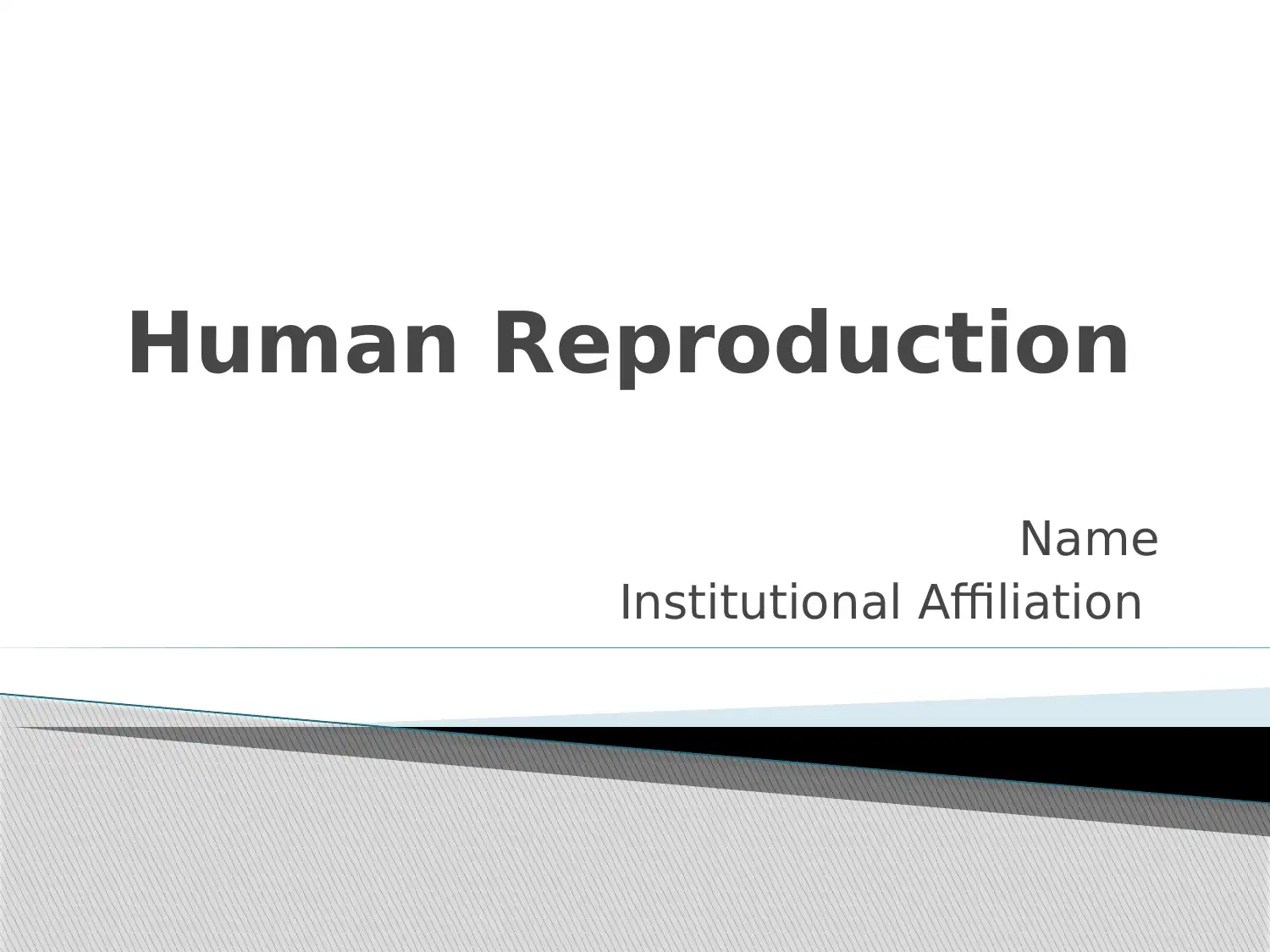
Human Reproduction
Name
Institutional Affiliation
Name
Institutional Affiliation
Secure Best Marks with AI Grader
Need help grading? Try our AI Grader for instant feedback on your assignments.

The human reproduction system is the organ
system that facilitates reproduction in human
beings. It is also the system through which human
beings give birth to live offspring’s.
The testes part of the male reproductive system
and ovaries part of the female reproductive system
produce the cells used in sexual reproduction.
These cells are also known as gametes. Besides,
they are also responsible for producing hormones
required for the effective functioning of the
systems as well as those responsible for derivative
sexual characteristics
Introduction
system that facilitates reproduction in human
beings. It is also the system through which human
beings give birth to live offspring’s.
The testes part of the male reproductive system
and ovaries part of the female reproductive system
produce the cells used in sexual reproduction.
These cells are also known as gametes. Besides,
they are also responsible for producing hormones
required for the effective functioning of the
systems as well as those responsible for derivative
sexual characteristics
Introduction

The male reproductive system is made up of
internal and external and external structures.
The external structures include the penis, scrotum
and testicles and the Epididymis.
The internal structures of the male reproductive
system include seminal vesicles, prostate gland,
Cowper’s glands, urethra, ejaculatory ducts and Vas
deferens.
The functioning of the male reproductive system is
dependent on testosterone hormone, luteinizing
hormone and Follicle stimulating hormone (Picut &
Remick, 2016).
Structure of the male Reproductive
system
internal and external and external structures.
The external structures include the penis, scrotum
and testicles and the Epididymis.
The internal structures of the male reproductive
system include seminal vesicles, prostate gland,
Cowper’s glands, urethra, ejaculatory ducts and Vas
deferens.
The functioning of the male reproductive system is
dependent on testosterone hormone, luteinizing
hormone and Follicle stimulating hormone (Picut &
Remick, 2016).
Structure of the male Reproductive
system
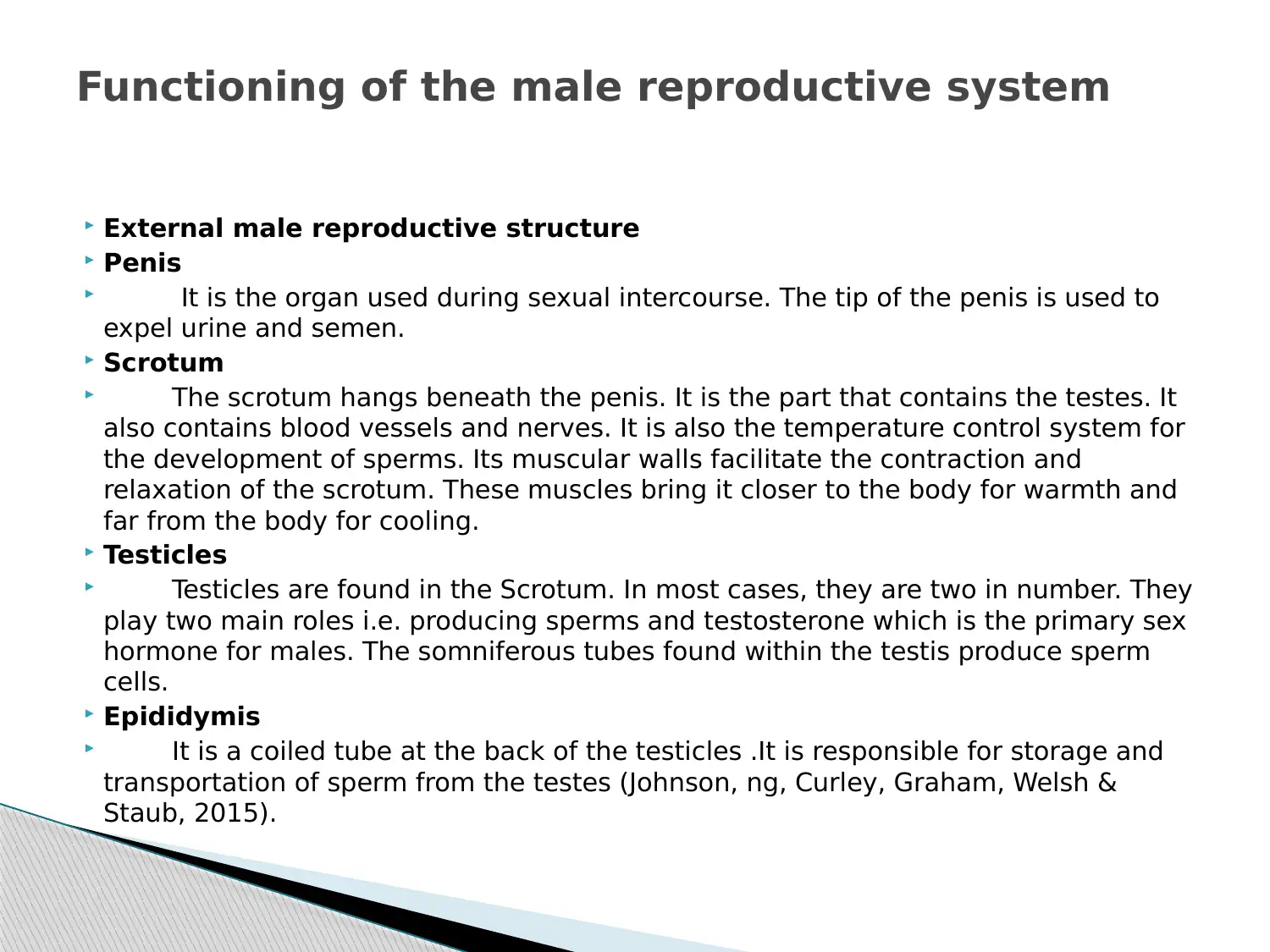
External male reproductive structure
Penis
It is the organ used during sexual intercourse. The tip of the penis is used to
expel urine and semen.
Scrotum
The scrotum hangs beneath the penis. It is the part that contains the testes. It
also contains blood vessels and nerves. It is also the temperature control system for
the development of sperms. Its muscular walls facilitate the contraction and
relaxation of the scrotum. These muscles bring it closer to the body for warmth and
far from the body for cooling.
Testicles
Testicles are found in the Scrotum. In most cases, they are two in number. They
play two main roles i.e. producing sperms and testosterone which is the primary sex
hormone for males. The somniferous tubes found within the testis produce sperm
cells.
Epididymis
It is a coiled tube at the back of the testicles .It is responsible for storage and
transportation of sperm from the testes (Johnson, ng, Curley, Graham, Welsh &
Staub, 2015).
Functioning of the male reproductive system
Penis
It is the organ used during sexual intercourse. The tip of the penis is used to
expel urine and semen.
Scrotum
The scrotum hangs beneath the penis. It is the part that contains the testes. It
also contains blood vessels and nerves. It is also the temperature control system for
the development of sperms. Its muscular walls facilitate the contraction and
relaxation of the scrotum. These muscles bring it closer to the body for warmth and
far from the body for cooling.
Testicles
Testicles are found in the Scrotum. In most cases, they are two in number. They
play two main roles i.e. producing sperms and testosterone which is the primary sex
hormone for males. The somniferous tubes found within the testis produce sperm
cells.
Epididymis
It is a coiled tube at the back of the testicles .It is responsible for storage and
transportation of sperm from the testes (Johnson, ng, Curley, Graham, Welsh &
Staub, 2015).
Functioning of the male reproductive system
Secure Best Marks with AI Grader
Need help grading? Try our AI Grader for instant feedback on your assignments.

Internal male reproductive system
structure
Urethra
Urethra is the tube responsible for passing urine from the bladder
to the outside. It also plays an additional role of ejaculating mature
sperm during orgasm.
Ejaculatory ducts.
They are responsible for passing sperm to the urethra during
ejaculation.
Seminal vesicles
They provide sperm with source of energy and aid in sperm
mobility through their sugar-rich fluid.
Prostate gland
It is located below the Urinary bladder. It is responsible for producing
additional fluid during ejaculation
Vas deferens
It is a muscular tube that transports sperm to the urethra during the
process of ejaculation (Foster, 2017).
structure
Urethra
Urethra is the tube responsible for passing urine from the bladder
to the outside. It also plays an additional role of ejaculating mature
sperm during orgasm.
Ejaculatory ducts.
They are responsible for passing sperm to the urethra during
ejaculation.
Seminal vesicles
They provide sperm with source of energy and aid in sperm
mobility through their sugar-rich fluid.
Prostate gland
It is located below the Urinary bladder. It is responsible for producing
additional fluid during ejaculation
Vas deferens
It is a muscular tube that transports sperm to the urethra during the
process of ejaculation (Foster, 2017).
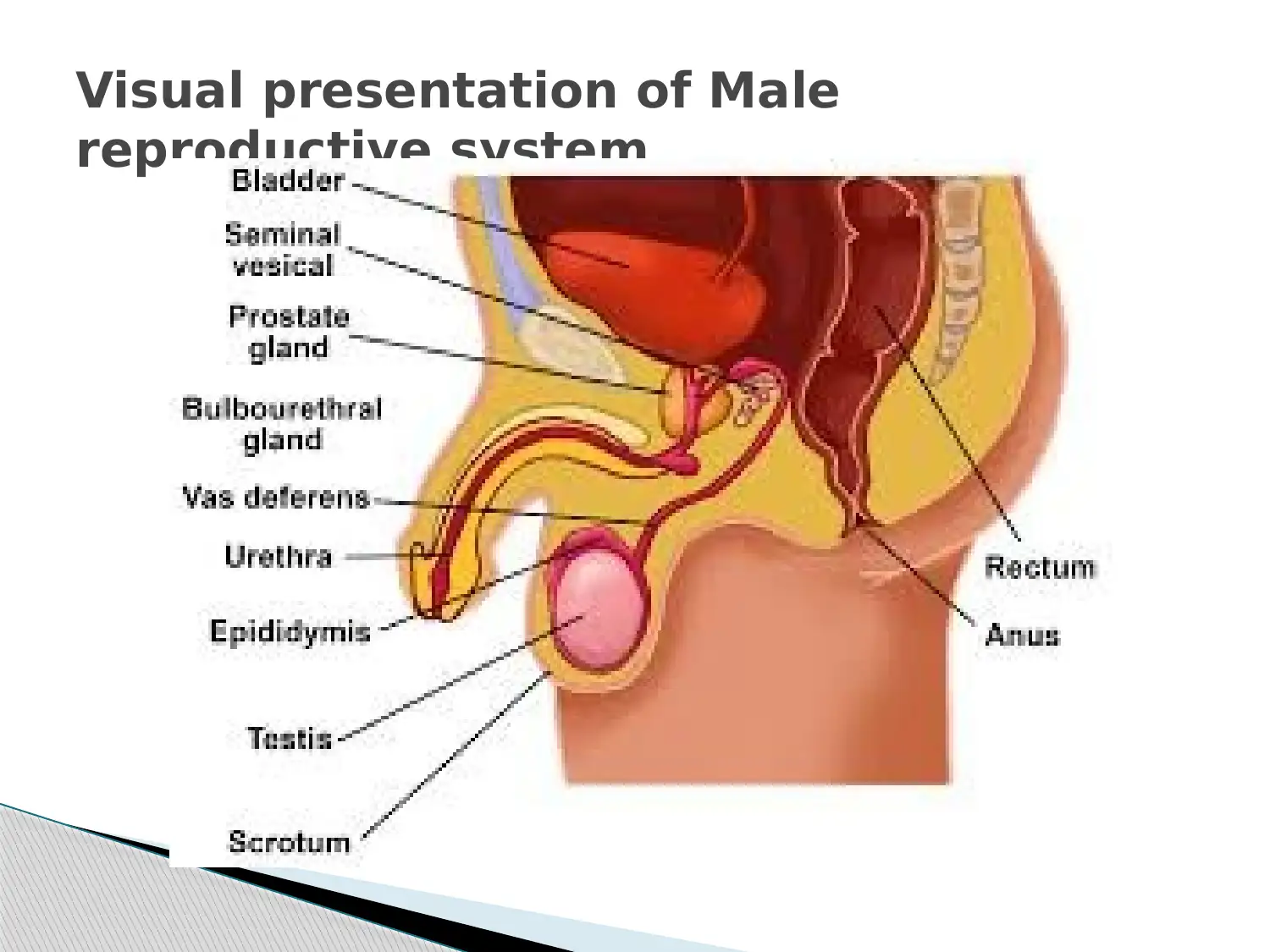
Visual presentation of Male
reproductive system
reproductive system
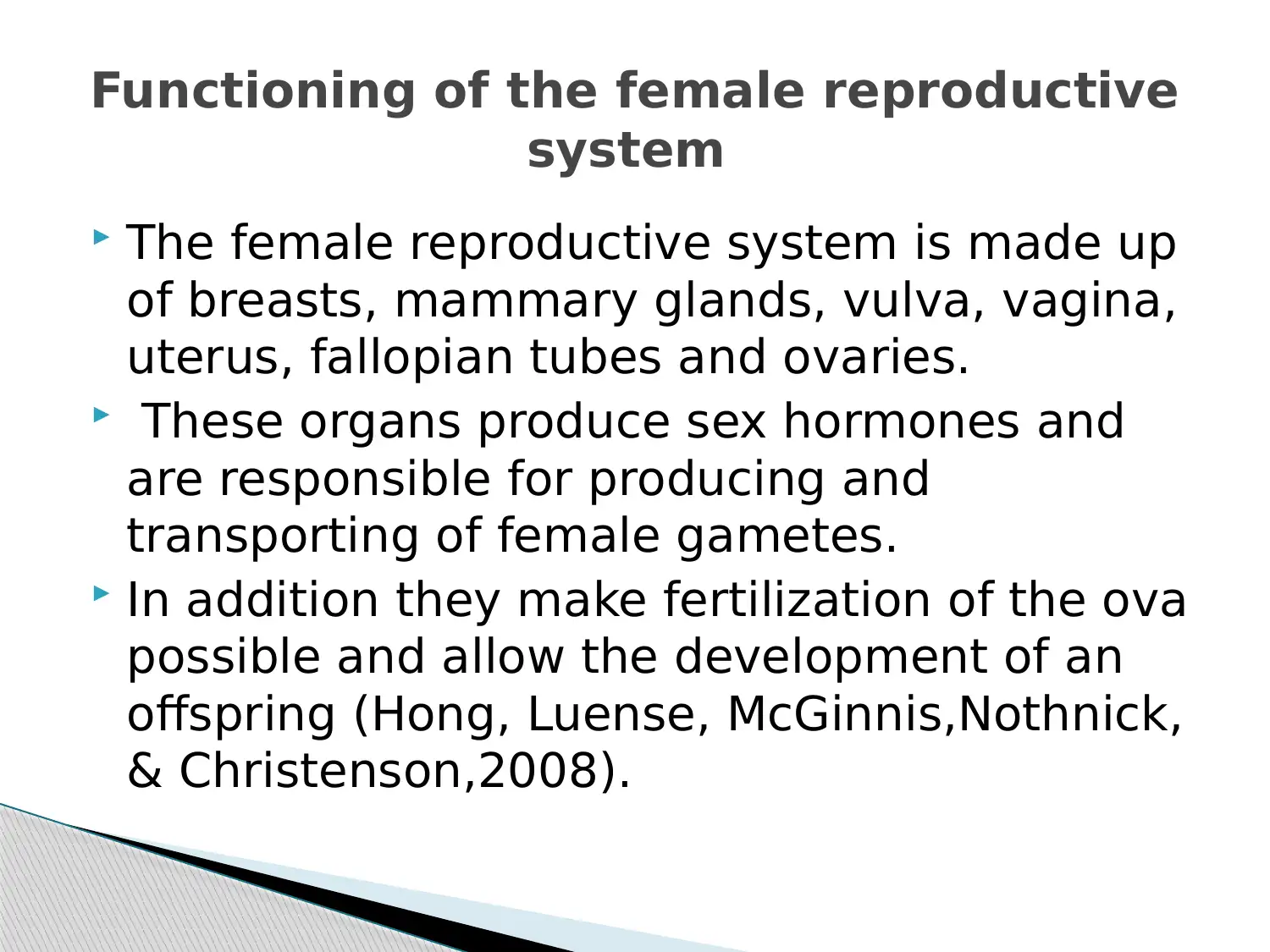
The female reproductive system is made up
of breasts, mammary glands, vulva, vagina,
uterus, fallopian tubes and ovaries.
These organs produce sex hormones and
are responsible for producing and
transporting of female gametes.
In addition they make fertilization of the ova
possible and allow the development of an
offspring (Hong, Luense, McGinnis,Nothnick,
& Christenson,2008).
Functioning of the female reproductive
system
of breasts, mammary glands, vulva, vagina,
uterus, fallopian tubes and ovaries.
These organs produce sex hormones and
are responsible for producing and
transporting of female gametes.
In addition they make fertilization of the ova
possible and allow the development of an
offspring (Hong, Luense, McGinnis,Nothnick,
& Christenson,2008).
Functioning of the female reproductive
system
Paraphrase This Document
Need a fresh take? Get an instant paraphrase of this document with our AI Paraphraser
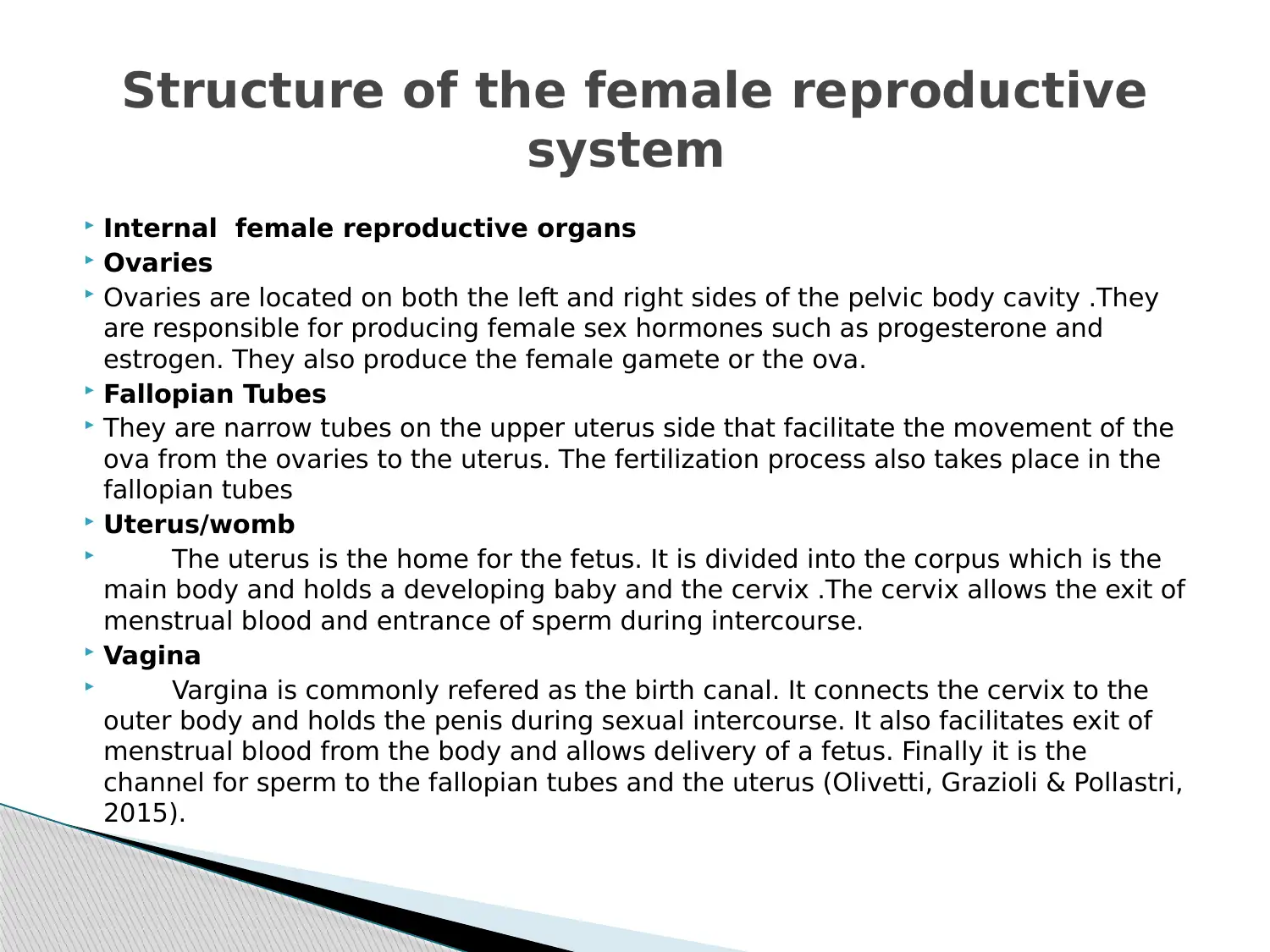
Internal female reproductive organs
Ovaries
Ovaries are located on both the left and right sides of the pelvic body cavity .They
are responsible for producing female sex hormones such as progesterone and
estrogen. They also produce the female gamete or the ova.
Fallopian Tubes
They are narrow tubes on the upper uterus side that facilitate the movement of the
ova from the ovaries to the uterus. The fertilization process also takes place in the
fallopian tubes
Uterus/womb
The uterus is the home for the fetus. It is divided into the corpus which is the
main body and holds a developing baby and the cervix .The cervix allows the exit of
menstrual blood and entrance of sperm during intercourse.
Vagina
Vargina is commonly refered as the birth canal. It connects the cervix to the
outer body and holds the penis during sexual intercourse. It also facilitates exit of
menstrual blood from the body and allows delivery of a fetus. Finally it is the
channel for sperm to the fallopian tubes and the uterus (Olivetti, Grazioli & Pollastri,
2015).
Structure of the female reproductive
system
Ovaries
Ovaries are located on both the left and right sides of the pelvic body cavity .They
are responsible for producing female sex hormones such as progesterone and
estrogen. They also produce the female gamete or the ova.
Fallopian Tubes
They are narrow tubes on the upper uterus side that facilitate the movement of the
ova from the ovaries to the uterus. The fertilization process also takes place in the
fallopian tubes
Uterus/womb
The uterus is the home for the fetus. It is divided into the corpus which is the
main body and holds a developing baby and the cervix .The cervix allows the exit of
menstrual blood and entrance of sperm during intercourse.
Vagina
Vargina is commonly refered as the birth canal. It connects the cervix to the
outer body and holds the penis during sexual intercourse. It also facilitates exit of
menstrual blood from the body and allows delivery of a fetus. Finally it is the
channel for sperm to the fallopian tubes and the uterus (Olivetti, Grazioli & Pollastri,
2015).
Structure of the female reproductive
system
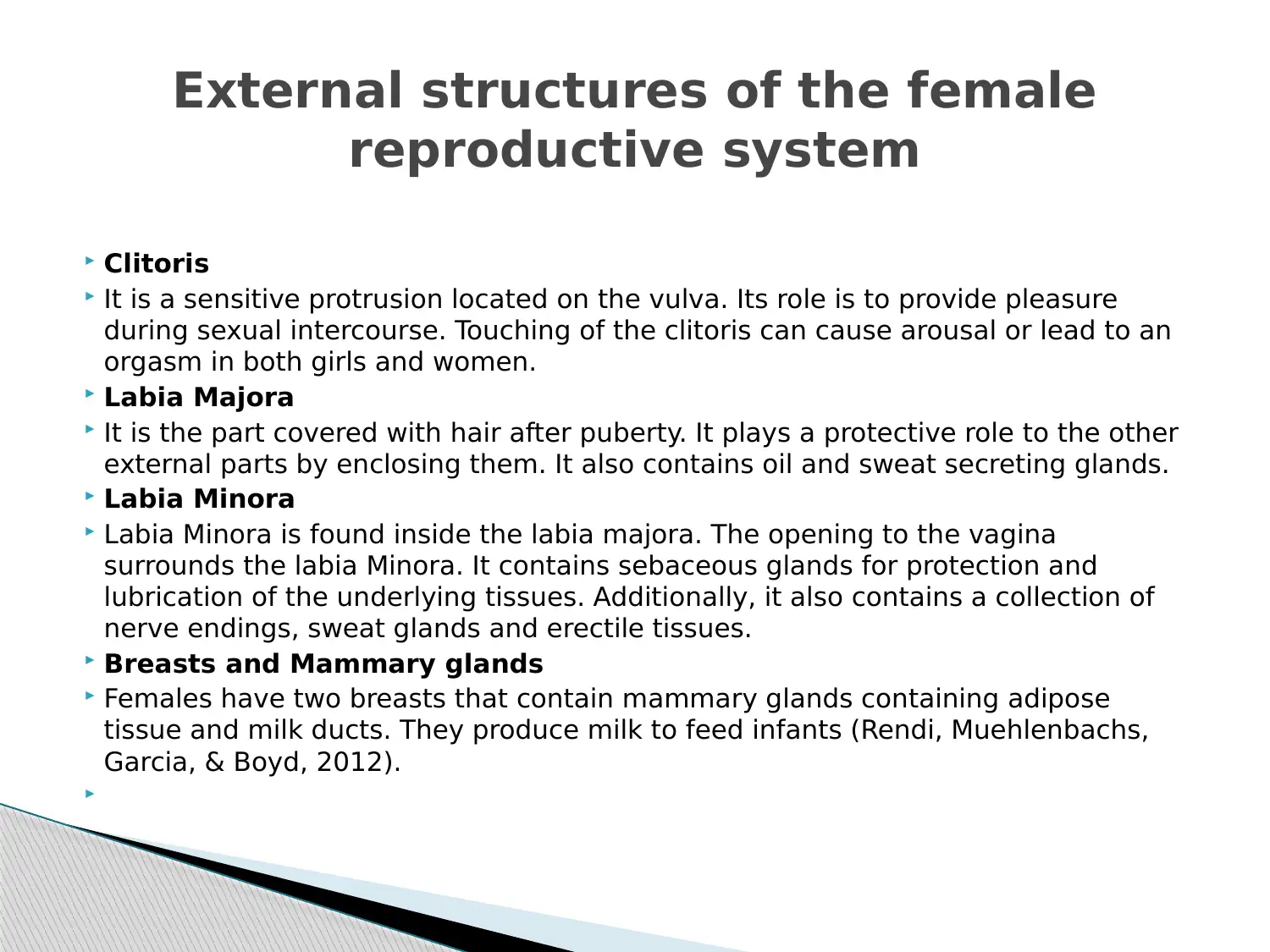
Clitoris
It is a sensitive protrusion located on the vulva. Its role is to provide pleasure
during sexual intercourse. Touching of the clitoris can cause arousal or lead to an
orgasm in both girls and women.
Labia Majora
It is the part covered with hair after puberty. It plays a protective role to the other
external parts by enclosing them. It also contains oil and sweat secreting glands.
Labia Minora
Labia Minora is found inside the labia majora. The opening to the vagina
surrounds the labia Minora. It contains sebaceous glands for protection and
lubrication of the underlying tissues. Additionally, it also contains a collection of
nerve endings, sweat glands and erectile tissues.
Breasts and Mammary glands
Females have two breasts that contain mammary glands containing adipose
tissue and milk ducts. They produce milk to feed infants (Rendi, Muehlenbachs,
Garcia, & Boyd, 2012).
External structures of the female
reproductive system
It is a sensitive protrusion located on the vulva. Its role is to provide pleasure
during sexual intercourse. Touching of the clitoris can cause arousal or lead to an
orgasm in both girls and women.
Labia Majora
It is the part covered with hair after puberty. It plays a protective role to the other
external parts by enclosing them. It also contains oil and sweat secreting glands.
Labia Minora
Labia Minora is found inside the labia majora. The opening to the vagina
surrounds the labia Minora. It contains sebaceous glands for protection and
lubrication of the underlying tissues. Additionally, it also contains a collection of
nerve endings, sweat glands and erectile tissues.
Breasts and Mammary glands
Females have two breasts that contain mammary glands containing adipose
tissue and milk ducts. They produce milk to feed infants (Rendi, Muehlenbachs,
Garcia, & Boyd, 2012).
External structures of the female
reproductive system
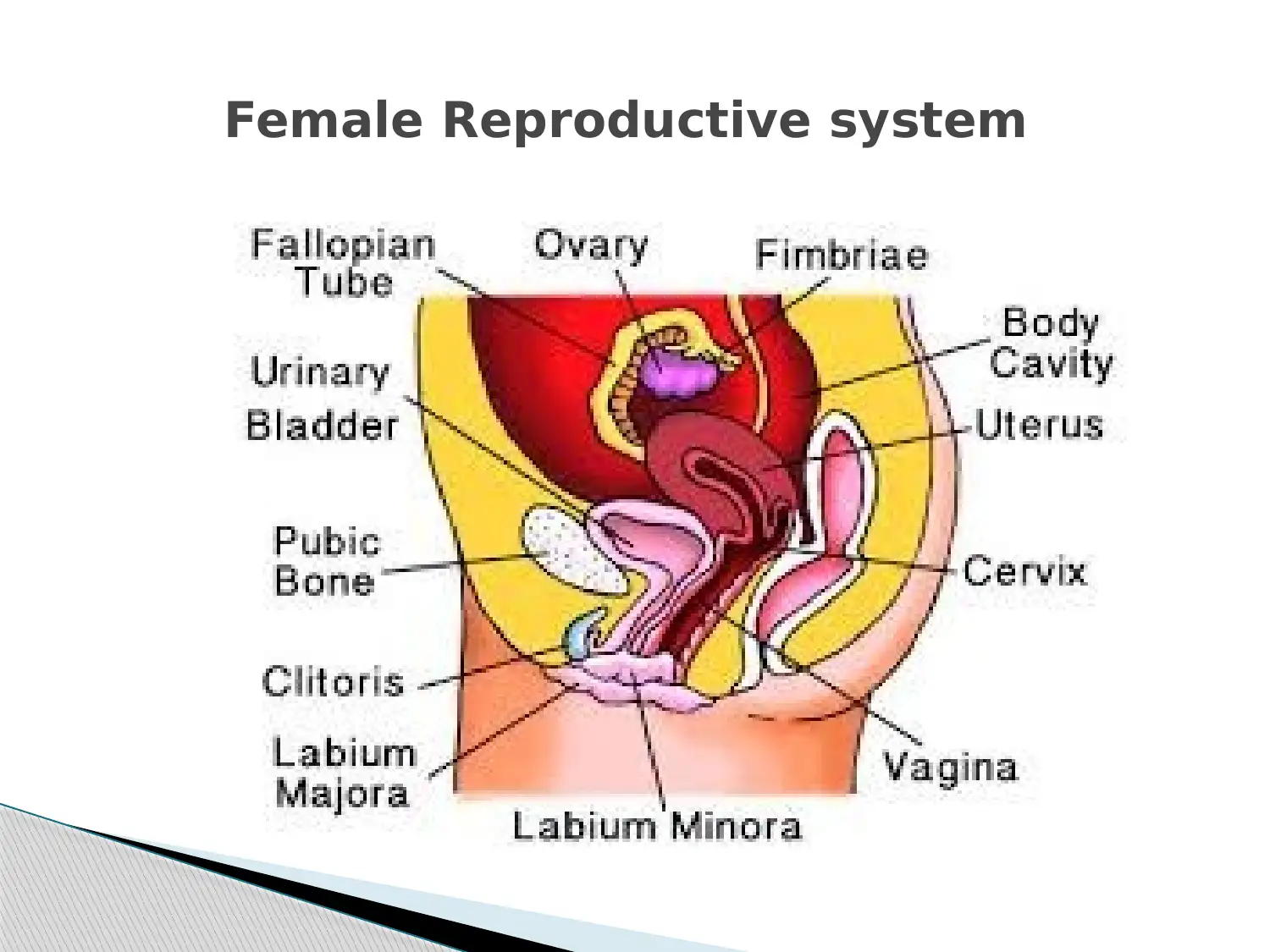
Female Reproductive system
Secure Best Marks with AI Grader
Need help grading? Try our AI Grader for instant feedback on your assignments.
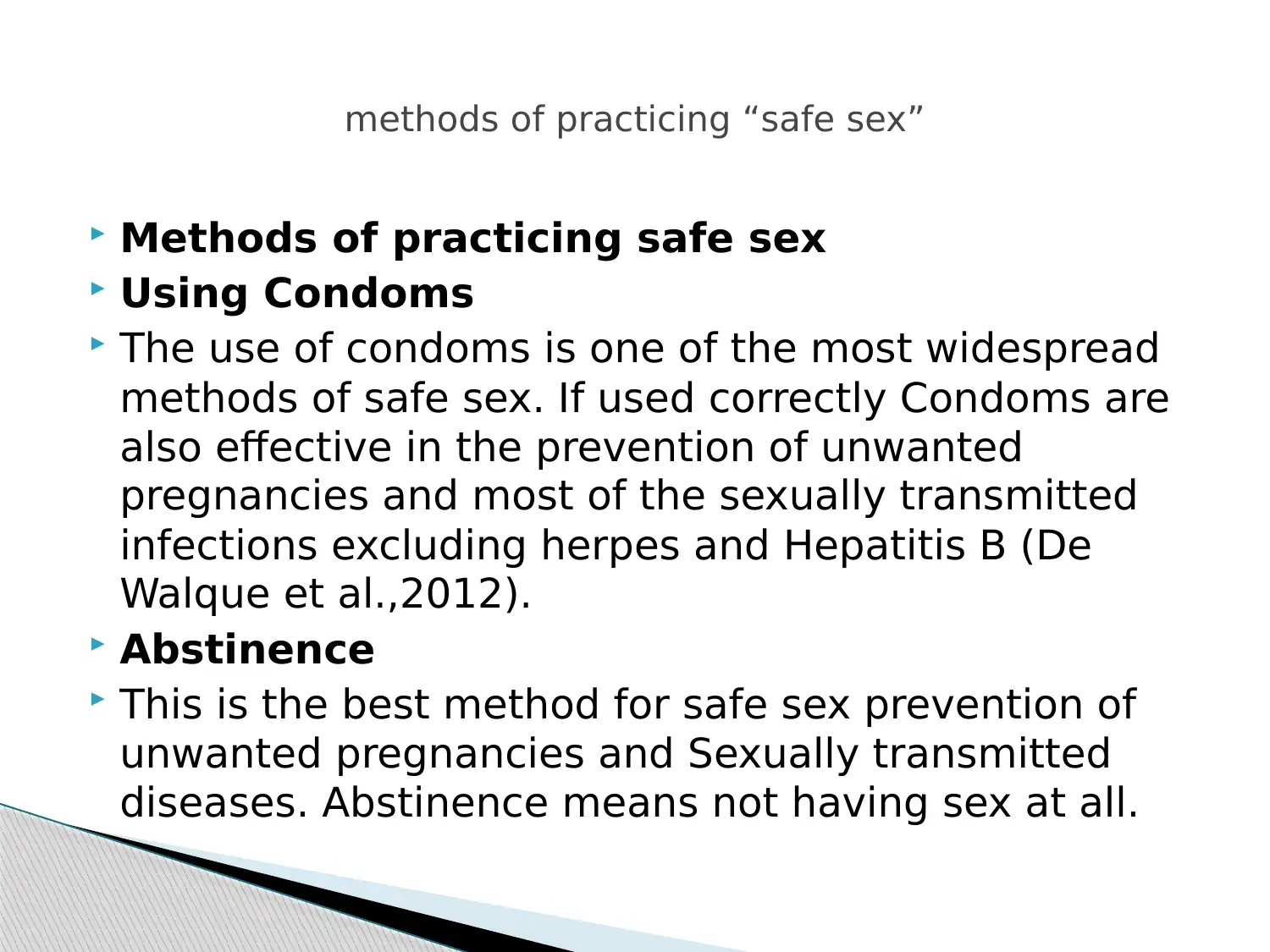
Methods of practicing safe sex
Using Condoms
The use of condoms is one of the most widespread
methods of safe sex. If used correctly Condoms are
also effective in the prevention of unwanted
pregnancies and most of the sexually transmitted
infections excluding herpes and Hepatitis B (De
Walque et al.,2012).
Abstinence
This is the best method for safe sex prevention of
unwanted pregnancies and Sexually transmitted
diseases. Abstinence means not having sex at all.
methods of practicing “safe sex”
Using Condoms
The use of condoms is one of the most widespread
methods of safe sex. If used correctly Condoms are
also effective in the prevention of unwanted
pregnancies and most of the sexually transmitted
infections excluding herpes and Hepatitis B (De
Walque et al.,2012).
Abstinence
This is the best method for safe sex prevention of
unwanted pregnancies and Sexually transmitted
diseases. Abstinence means not having sex at all.
methods of practicing “safe sex”
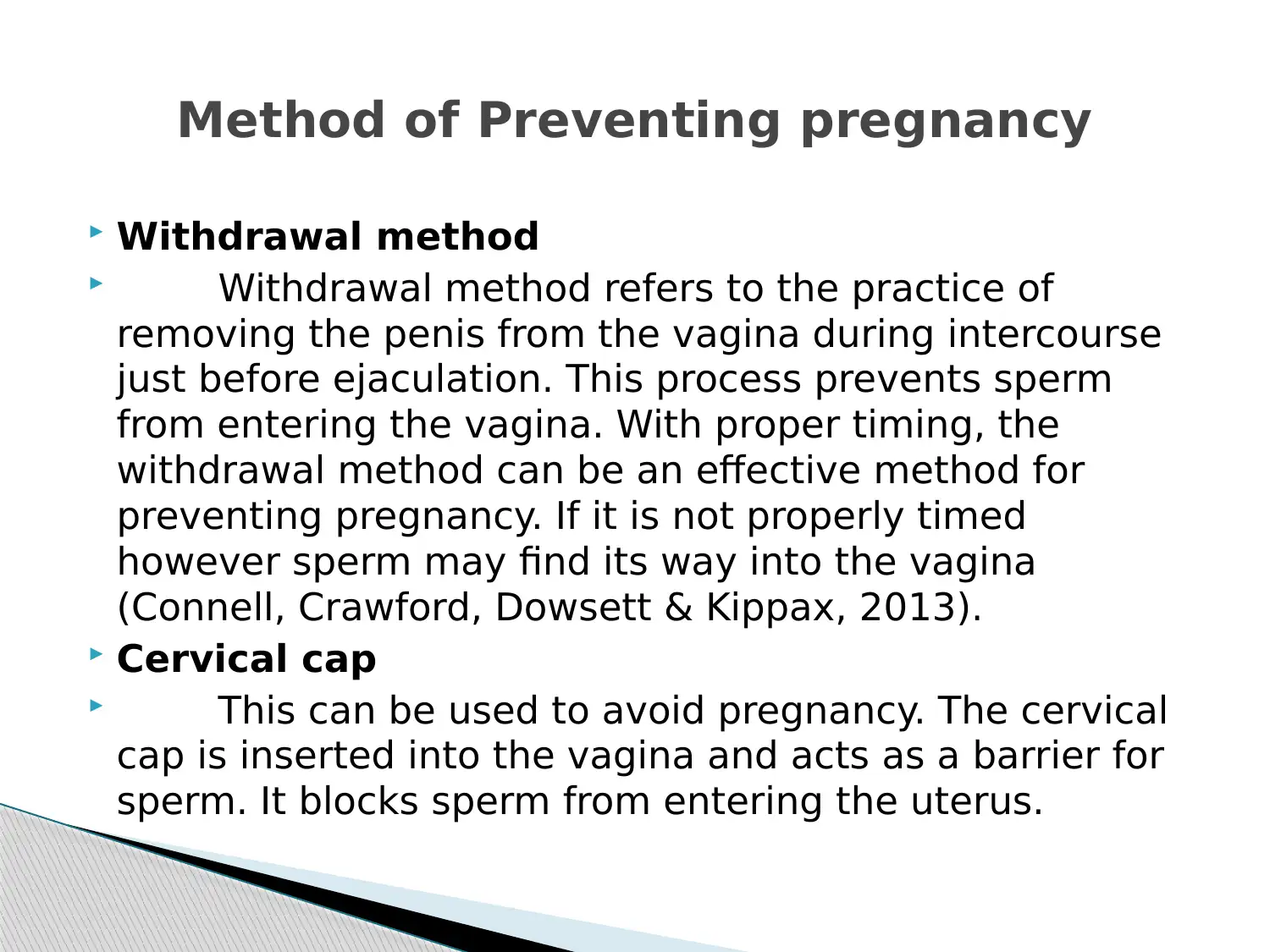
Withdrawal method
Withdrawal method refers to the practice of
removing the penis from the vagina during intercourse
just before ejaculation. This process prevents sperm
from entering the vagina. With proper timing, the
withdrawal method can be an effective method for
preventing pregnancy. If it is not properly timed
however sperm may find its way into the vagina
(Connell, Crawford, Dowsett & Kippax, 2013).
Cervical cap
This can be used to avoid pregnancy. The cervical
cap is inserted into the vagina and acts as a barrier for
sperm. It blocks sperm from entering the uterus.
Method of Preventing pregnancy
Withdrawal method refers to the practice of
removing the penis from the vagina during intercourse
just before ejaculation. This process prevents sperm
from entering the vagina. With proper timing, the
withdrawal method can be an effective method for
preventing pregnancy. If it is not properly timed
however sperm may find its way into the vagina
(Connell, Crawford, Dowsett & Kippax, 2013).
Cervical cap
This can be used to avoid pregnancy. The cervical
cap is inserted into the vagina and acts as a barrier for
sperm. It blocks sperm from entering the uterus.
Method of Preventing pregnancy
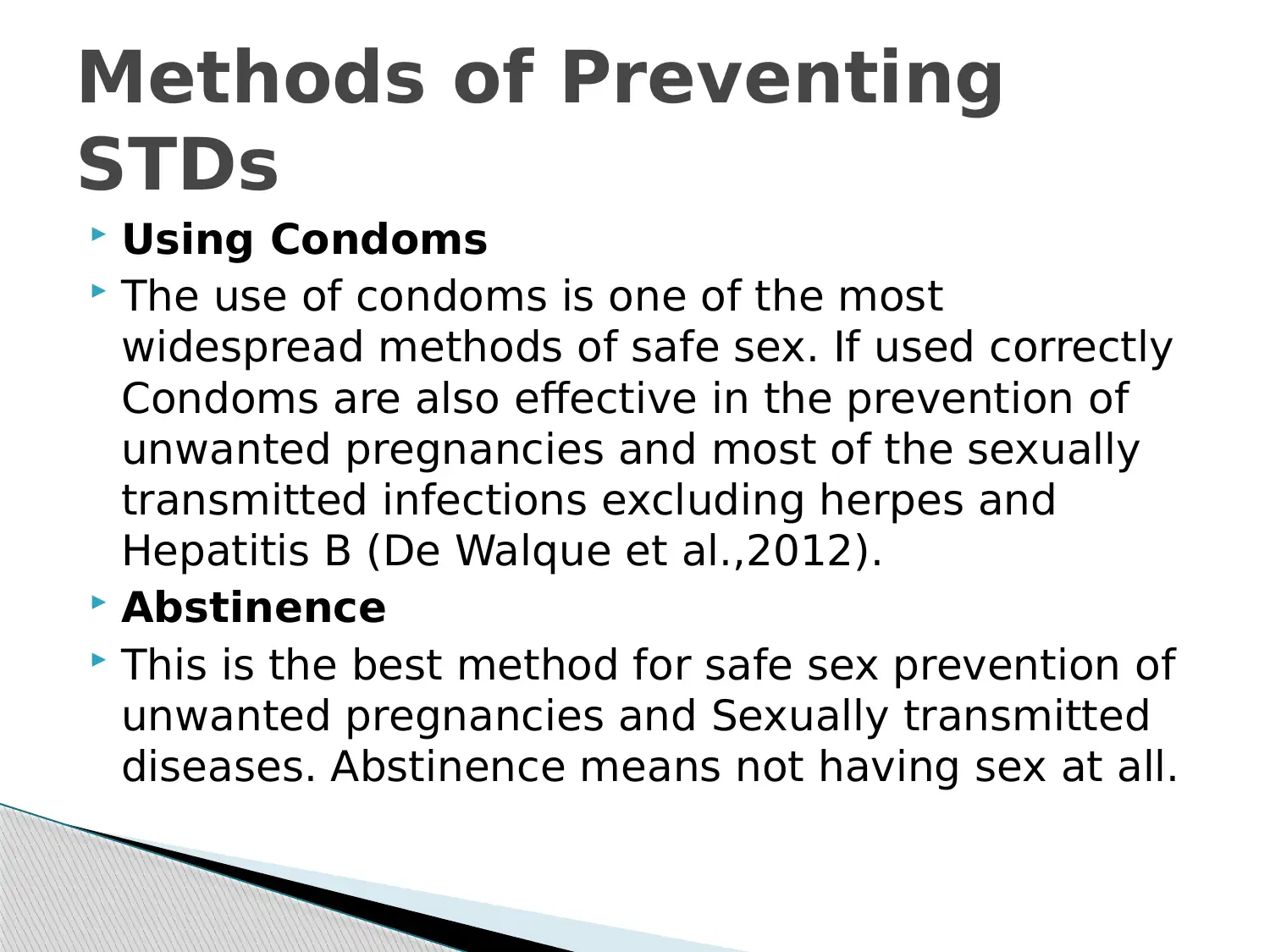
Using Condoms
The use of condoms is one of the most
widespread methods of safe sex. If used correctly
Condoms are also effective in the prevention of
unwanted pregnancies and most of the sexually
transmitted infections excluding herpes and
Hepatitis B (De Walque et al.,2012).
Abstinence
This is the best method for safe sex prevention of
unwanted pregnancies and Sexually transmitted
diseases. Abstinence means not having sex at all.
Methods of Preventing
STDs
The use of condoms is one of the most
widespread methods of safe sex. If used correctly
Condoms are also effective in the prevention of
unwanted pregnancies and most of the sexually
transmitted infections excluding herpes and
Hepatitis B (De Walque et al.,2012).
Abstinence
This is the best method for safe sex prevention of
unwanted pregnancies and Sexually transmitted
diseases. Abstinence means not having sex at all.
Methods of Preventing
STDs
Paraphrase This Document
Need a fresh take? Get an instant paraphrase of this document with our AI Paraphraser
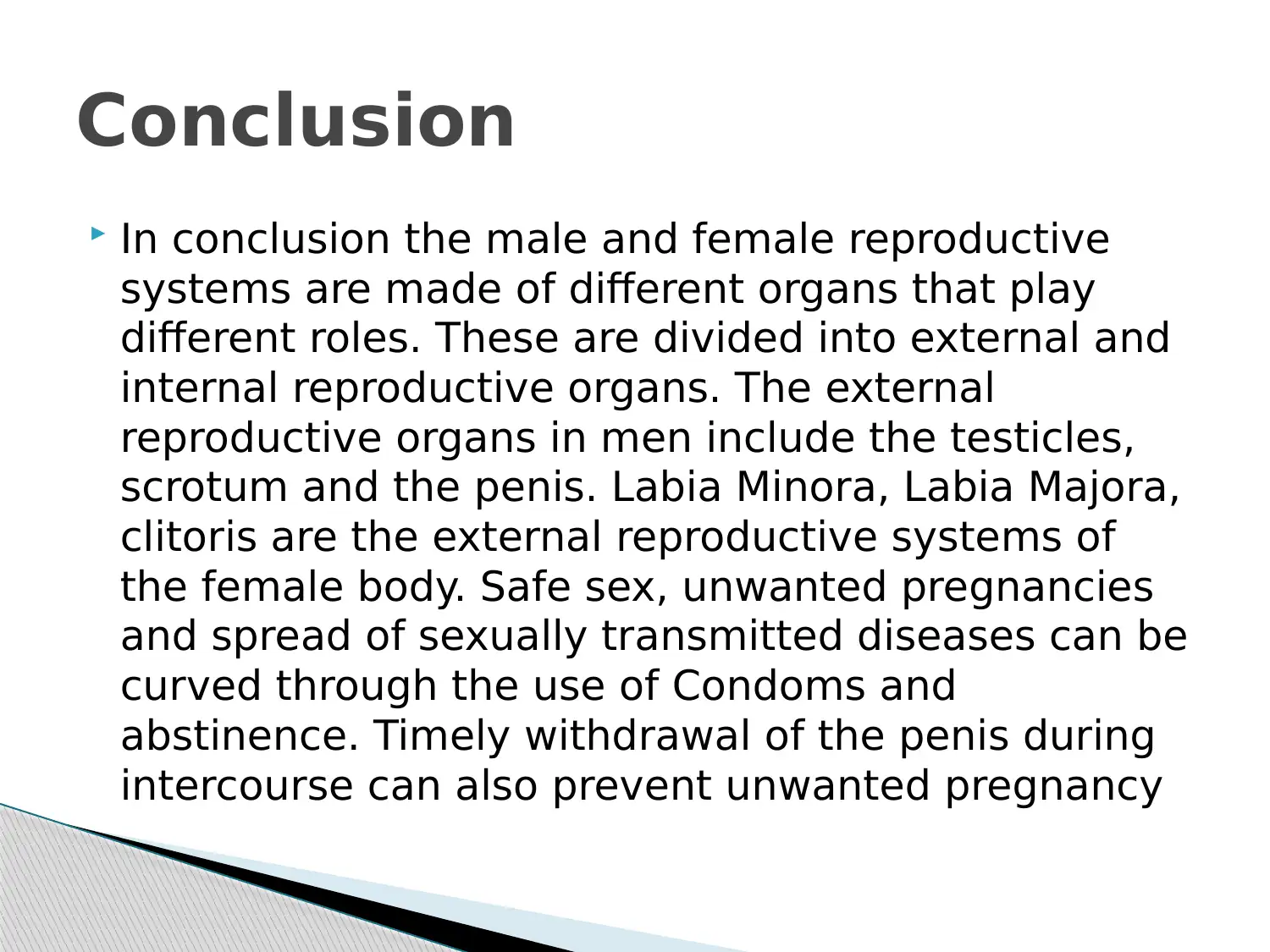
In conclusion the male and female reproductive
systems are made of different organs that play
different roles. These are divided into external and
internal reproductive organs. The external
reproductive organs in men include the testicles,
scrotum and the penis. Labia Minora, Labia Majora,
clitoris are the external reproductive systems of
the female body. Safe sex, unwanted pregnancies
and spread of sexually transmitted diseases can be
curved through the use of Condoms and
abstinence. Timely withdrawal of the penis during
intercourse can also prevent unwanted pregnancy
Conclusion
systems are made of different organs that play
different roles. These are divided into external and
internal reproductive organs. The external
reproductive organs in men include the testicles,
scrotum and the penis. Labia Minora, Labia Majora,
clitoris are the external reproductive systems of
the female body. Safe sex, unwanted pregnancies
and spread of sexually transmitted diseases can be
curved through the use of Condoms and
abstinence. Timely withdrawal of the penis during
intercourse can also prevent unwanted pregnancy
Conclusion
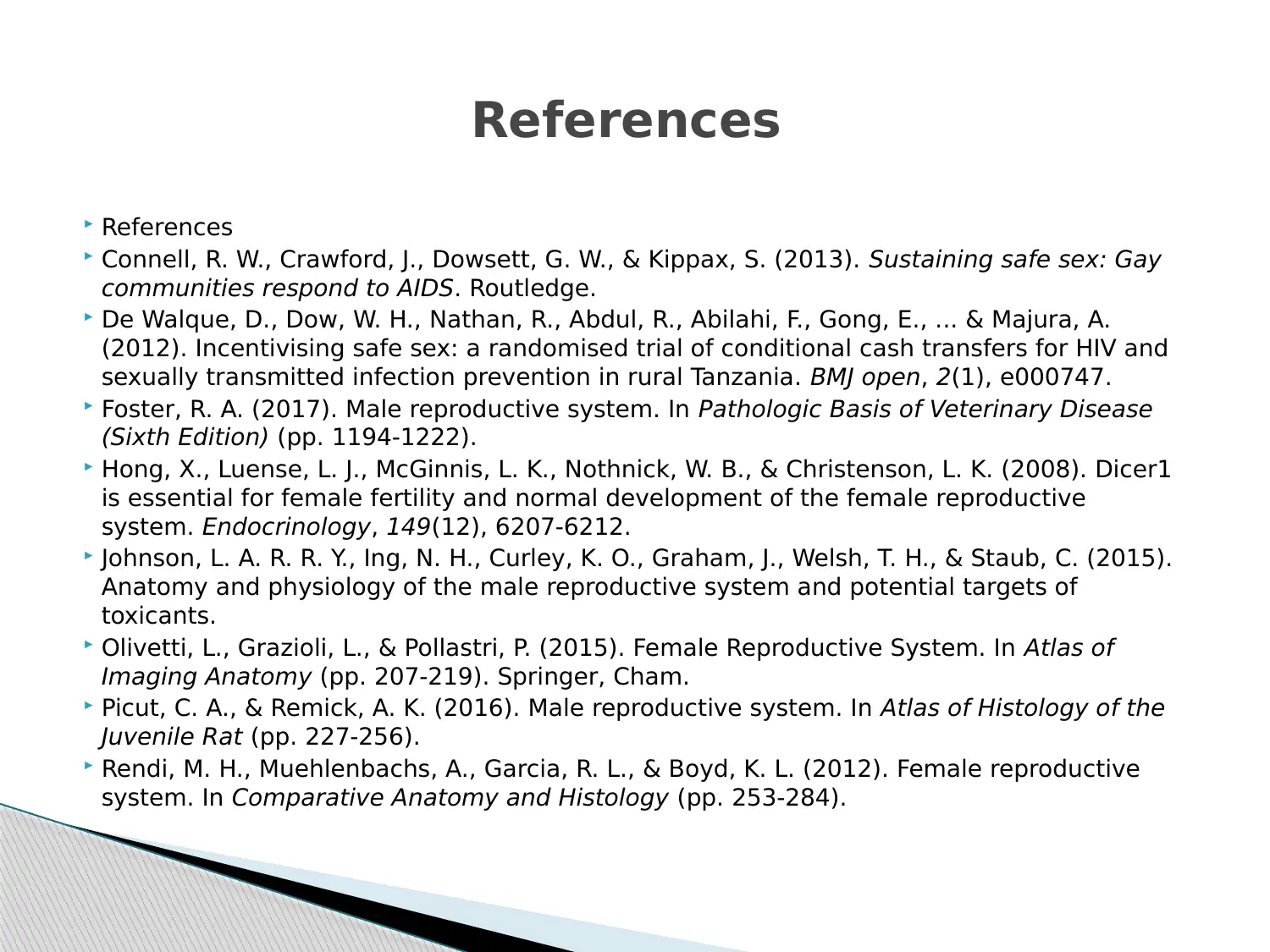
References
Connell, R. W., Crawford, J., Dowsett, G. W., & Kippax, S. (2013). Sustaining safe sex: Gay
communities respond to AIDS. Routledge.
De Walque, D., Dow, W. H., Nathan, R., Abdul, R., Abilahi, F., Gong, E., ... & Majura, A.
(2012). Incentivising safe sex: a randomised trial of conditional cash transfers for HIV and
sexually transmitted infection prevention in rural Tanzania. BMJ open, 2(1), e000747.
Foster, R. A. (2017). Male reproductive system. In Pathologic Basis of Veterinary Disease
(Sixth Edition) (pp. 1194-1222).
Hong, X., Luense, L. J., McGinnis, L. K., Nothnick, W. B., & Christenson, L. K. (2008). Dicer1
is essential for female fertility and normal development of the female reproductive
system. Endocrinology, 149(12), 6207-6212.
Johnson, L. A. R. R. Y., Ing, N. H., Curley, K. O., Graham, J., Welsh, T. H., & Staub, C. (2015).
Anatomy and physiology of the male reproductive system and potential targets of
toxicants.
Olivetti, L., Grazioli, L., & Pollastri, P. (2015). Female Reproductive System. In Atlas of
Imaging Anatomy (pp. 207-219). Springer, Cham.
Picut, C. A., & Remick, A. K. (2016). Male reproductive system. In Atlas of Histology of the
Juvenile Rat (pp. 227-256).
Rendi, M. H., Muehlenbachs, A., Garcia, R. L., & Boyd, K. L. (2012). Female reproductive
system. In Comparative Anatomy and Histology (pp. 253-284).
References
Connell, R. W., Crawford, J., Dowsett, G. W., & Kippax, S. (2013). Sustaining safe sex: Gay
communities respond to AIDS. Routledge.
De Walque, D., Dow, W. H., Nathan, R., Abdul, R., Abilahi, F., Gong, E., ... & Majura, A.
(2012). Incentivising safe sex: a randomised trial of conditional cash transfers for HIV and
sexually transmitted infection prevention in rural Tanzania. BMJ open, 2(1), e000747.
Foster, R. A. (2017). Male reproductive system. In Pathologic Basis of Veterinary Disease
(Sixth Edition) (pp. 1194-1222).
Hong, X., Luense, L. J., McGinnis, L. K., Nothnick, W. B., & Christenson, L. K. (2008). Dicer1
is essential for female fertility and normal development of the female reproductive
system. Endocrinology, 149(12), 6207-6212.
Johnson, L. A. R. R. Y., Ing, N. H., Curley, K. O., Graham, J., Welsh, T. H., & Staub, C. (2015).
Anatomy and physiology of the male reproductive system and potential targets of
toxicants.
Olivetti, L., Grazioli, L., & Pollastri, P. (2015). Female Reproductive System. In Atlas of
Imaging Anatomy (pp. 207-219). Springer, Cham.
Picut, C. A., & Remick, A. K. (2016). Male reproductive system. In Atlas of Histology of the
Juvenile Rat (pp. 227-256).
Rendi, M. H., Muehlenbachs, A., Garcia, R. L., & Boyd, K. L. (2012). Female reproductive
system. In Comparative Anatomy and Histology (pp. 253-284).
References
1 out of 15
Related Documents
Your All-in-One AI-Powered Toolkit for Academic Success.
+13062052269
info@desklib.com
Available 24*7 on WhatsApp / Email
![[object Object]](/_next/static/media/star-bottom.7253800d.svg)
Unlock your academic potential
© 2024 | Zucol Services PVT LTD | All rights reserved.





